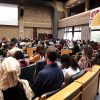Sunday, May 12, 2024
News and Views from the Global South
ARTS: A Way of Seeing African Women
- It would be easy to walk past the Dapper Museum without giving the building a second glance were it not for the striking images of African women at the entrance. Tucked in a side street of the 16th arrondissement, just off the chic avenue Victor Hugo, the Dapper has an unremarkable facade and lies far from the gleaming Louvre and Orsay museums. But its exhibitions stand out in a city filled with museums, galleries and blockbuster art shows.
The Dapper is devoted to the arts and culture of Africa, the Caribbean and “their diasporas”, and it currently has its own attention-grabbing show of more than 150 traditional objects as well as pictures by the Cameroon-born photographer Angele Etoundi Essamba.
Titled Femmes dans les arts d’Afrique (Women in the arts of Africa), the exhibition runs until Jul. 12 and gives a diverse and remarkable view of the representation of women in various African regions. Most of the figures, from areas such as Mozambique, Benin, Ghana and Congo, seem to show a reverence for women and particularly their role as mothers. Indeed, many of the objects celebrate maternity, showing engorged breasts and protruding abdomens to such an extent that one visitor was heard to mutter, “If I see another pregnant statue, I’m going to scream.”
But motherhood is a particularly important theme in African art, says Bonny Gabin, the Dapper Museum’s cultural attaché. “The mother is the one that allows societies to continue, so she has a special status,” he adds. “Of course, it is also important to remember that these objects are created by men in their role as artists and smiths, with women providing the inspiration, so there is an idealisation of maternity.”
Some of the most arresting pieces in the exhibition depict women with infants suckling at the breast: they include a painted wooden piece from Congo that shows a woman sitting cross-legged while nursing a child cradled on her thighs, one of her hands supporting his head; and an elongated seated figure from the Cote d’Ivoire, with massively upright breasts feeding a baby.
In the contemporary section, meanwhile, a few of Essamba’s huge photographs also depict pregnant women or mothers with children, and her work includes black-and-white portraits of herself pregnant as well as carrying her son on her back in a traditional wrap.
“It’s true that even now in African societies, a woman who cannot have children may feel excluded. Not being able to have children is a huge burden, and the Western idea of choosing not to have children when one is able to have them is incomprehensible to many people,” says the 47-year-old Essamba, who left Cameroon when she was 10 years old, attended high school in France and has lived in the Netherlands for more than 20 years.
“Motherhood is seen as a blessing in African societies,” she continues. “The mother is regarded as the root of and continuation of life.”
But Essamba’s pictures, like the traditional section of the exhibition, show women in many other roles. One broad colour photograph portrays a brightly dressed fisherwoman standing in the sunlight and casting her net into the ocean. Essamba also shows modern women posed with ancestral objects, such as fertility symbols or masks, to demonstrate how “we are linked with the past.”
In the traditional segment of the show, the wooden figures also depict women as dancers, advisers and positive forces of nature (or what may sometimes be called “divinities”, says Gabin). A famous piece, originating from Cameroon and collected in the 1800s, is remarkable for its sense of movement, and has provided inspiration to photographers such as Man Ray. Other objects recall Egyptian statues by the beauty of their form and expression, and Egypt itself is represented with figures of goddesses and couples.
The Ancient Kingdom of Benin (now Nigeria) accounts for some impressive figurative heads in bronze depicting the “queen-mother” or “iyoba” as a symbol of stability and protection. Other regions have produced similar heads in terra-cotta and stone, showing the importance given to the mother of the ruling sovereign.
“In all these objects, women are celebrated with grandeur, and there is no form of misogyny at all,” Essamba says.
But the celebration of the female role in African arts is paradoxical when one considers the continuing cases of violence against women in several war- torn countries such as the Sudan and Congo, where many women and even young girls have been brutally raped. How do artists see this paradox?
“In war, women are always the victim of atrocities, and that is a sad fact,” Essamba says. “But in my work I try to show our strength as well our fragility, to show how we survive in spite of our wounds. What I want viewers to take from the exhibition is the idea of strength.”
Gabin adds that “attacks against women are attacks against the society, and also a way for men to humiliate other men through the abuse of women. It is the artists, among others, who protest at the treatment of women through their work.”
Aware that visitors to the exhibition may have questions about this issue and others, the museum has organised talks about the role of women in polygamous societies, and debates on the effects of female genital mutilation and the movement to abolish the practice.
Above all, however, the exhibition aims to show the diversity of women’s roles, via art, in African societies. “We need to change prejudices and the way of seeing women,” Essamba says, “and I hope the show helps to accomplish this.”

 Print
Print




